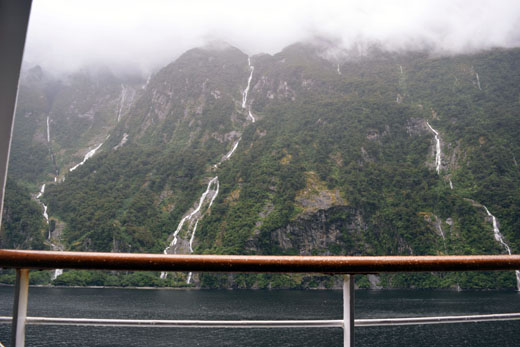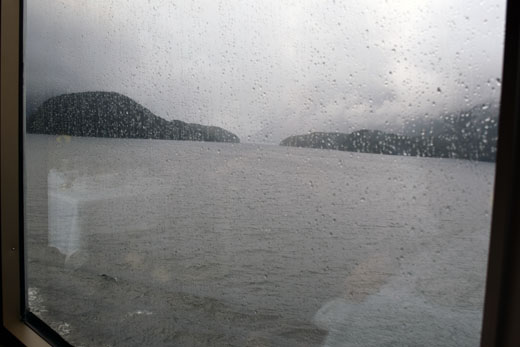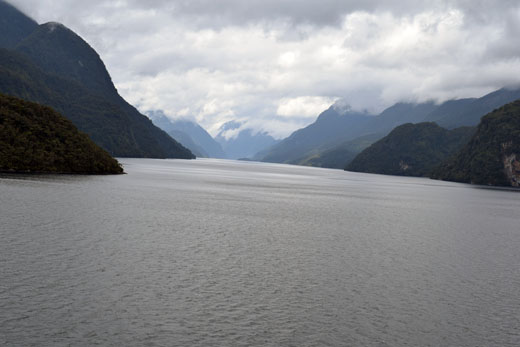
Editor’s Note: This is the 13th in a series of stories researched during Don and Nancy Harrison’s 50th Wedding Anniversary cruise from Sydney, Australia, to San Diego. Previous installments of the series, which runs every Thursday, may be found by tapping the number of the installment: 1, 2, 3, 4, 5, 6, 7, 8, 9, 10, 11, 12
By Donald H. Harrison

FJORDLAND NATIONAL PARK, New Zealand –Our cruise ship MS Maasdam proceeded at a leisurely speed through Milford Sound, the first of three wonders we would visit along the southwest side of New Zealand’s South Island. Considered New Zealand’s most popular tourist destination, this is a place where any sense of hurry should be permanently banished.
From our balcony, as we sipped our morning coffee and enjoyed a continental breakfast brought to us by Susandri, our Indonesian cabin steward, Nancy and I could look up, up, up the granite face of the mountains to search for a glimpse of their peaks perhaps peeking through the swirling mist. Milford Sound receives an average of 252 inches of rain per year, so we were grateful that the weather allowed us to be outside on the balcony. Along the sides of the cliff face, which is covered by moss and lichens, were dozens, if not more, temporary waterfalls painting white ribbons amid the vertical fields of green.
On the ship’s loudspeaker system, our Holland America tour expert, David Happe, explained to us how some of this sensational scenery came about. Although this dramatic area is called Milford “Sound,” in fact, it is not a sound at all; it is a fjord dug out of the earth over many centuries by glaciers.
The dense ice packs are formed by snow that falls at the top of the mountain and then works its way down through a back and forth process of accumulation and melting. “When the rate of melting is less than that of accumulation, it begins to condense into an ice pack,” Happe explained. “Eventually gravity takes over, and it (the ice pack) becomes a river of ice and is pulled down to lower elevations. Over the years glaciers continue to grow, sometimes thousands of meters thick.
“The process of advancing and retreat will take up rocks and leave some very deep features in the landscape,” Happe continued. “Some come in the form of hanging valleys, which you can see on our right or starboard side. Glaciers come down to the sea and as they ultimately retreat and disappear, those deep valleys become covered by water, and those are the fjords.”
A bit later in the narration, Happe turned our attention to the temporary waterfalls. “There is not a lot of area for the water to be absorbed because of the thickness, or toughness, of the granite,” he commented. “It’s a sheer vertical drop, and yet there is all this vegetation around; how can that be? There are cracks within the granite where moss and lichen can take root and by doing this, they will more or less create a foundation on the rock face that will allow seeds to be deposited there by birds and eventually for trees to grow. When these seeds are dropped to the moss and lichen they will germinate, and they themselves will try to find cracks in the rocks for their root system to take hold.
“If they can’t do that, they will latch onto the moss and lichen and other trees around them and begin to intertwine to create a communal support system of precarious survival. It is very practical for this kind of condition, but it does have its drawbacks. If you have a heavy downpour, or an earthquake, that can create a lot of sliding. If one tree falls, it is going to take others with it.”
As I sat musing on the balcony, I couldn’t help but think of the applicability of Happe’s words to other situations.
“A communal support system of precarious survival … If one tree falls, it is going to take others with it,” he had said. In other words, they must depend on one another. Trees, we assume, are passive subjects in the face of natural occurrences. But we humans, we Jews, have the will to be able to band together, to hold onto each other, as well as to our common values, in the face of anti- Semitism, BDS campaigns, and vilification. I found myself remembering the lyric about the Torah: “It’s a tree of life for those who hold fast to it.”
Happe also provided us with a little history of Milford Sound, which Captain James Cook bypassed during his 18th century voyages along the New Zealand coast. In 1810, Captain John Grono, master of the sealing ship Governor Bligh (yup, named for Captain Bligh of Mutiny on the Bounty fame) pulled into the fjord looking for shelter, and after coming to a 90-degree turn, he went deeper inside the fjord to explore. He gave the fjord the name “Milford Haven” after his birthplace in Wales. Forty years later, John Lort Stokes, another ship’s captain, renamed it Milford Sound, and the name, though geographically incorrect, stuck
The indigenous Maori people, of course, knew all about the fjord, its tidal action and fish migrations for centuries before the Europeans came. And they knew that within this fjord which they called Piopiotahi could be found deposits of greenstone, or pounamu, a mineral of pure translucent green that could be used for weapons and ornaments. Today, mining is not permitted in Fjordland National Park, as it is a protected world heritage site.
The other two venues our ship visited were Doubtful Sound and Dusky Sound, which while spectacular in themselves, were somewhat anti-climactic following our passage through Milford Sound. Doubtful’s and Dusky’s average yearly rainfall both top out at 240 inches, only a little less than that of Milford Sound, which is considered one of the wettest places on earth.

Doubtful Sound was named Doubtful Harbor by Captain Cook in 1770, but he did not stop to explore the 2-mile long inlet. The mountains casting their shadow into its placid waters are not so tall or vertical as those at Milford Sound. The area was visited by Spanish cartographers who gave it many of its place names, including Febrero Point, Pandulo Reach, and Malaspina Reach.
A fascinating aspect of Doubtful Sound is that it has two types of water, one overlaying the other. At the bottom is sea water, at the top is runoff water made brown by leaching tannins from the forest. The dark water prevents light from penetrating too deeply into the fjord, prompting the growth of underwater plant life that normally would be found at much greater depths of the ocean.

Dusky Sound, reportedly named by Captain Cook after the appearance it gave on first sighting, is a breeding area for Fjordland Penguins. They are among a great variety of bird life including woodhens, ducks, geese, parrots, pigeons, petrels, shags, and curlews. Sea mammals including whales and seals also make their appearance there from time to time.
Our leisurely passage through the Milford, Doubtful, and Dusky Sounds was a fine introduction to the beauty of New Zealand. We felt very privileged to be able to see these sites up close, without ever having to leave the comfort of the cruise ship.
*
Harrison is editor of San Diego Jewish World. He may be contacted via donald.harrison@sdjewishworld.com
Pingback: Cushion stars and tuataras in Picton, N.Z. | San Diego Jewish World
Pingback: A posthumous salute for Rabbi Katz of Wellington | San Diego Jewish World